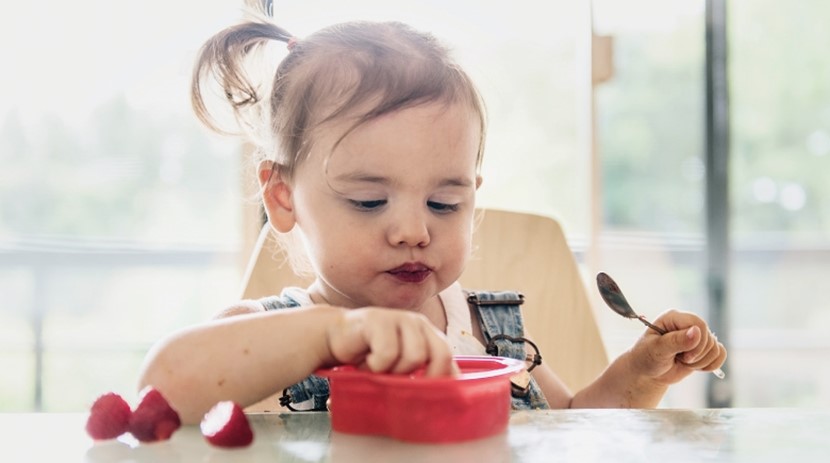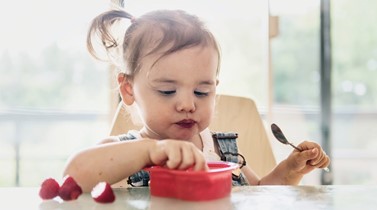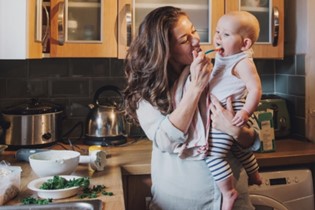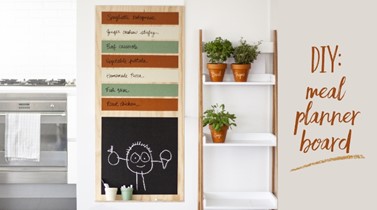Healthy lunchbox ideas your child will actually eat

There’s something so satisfying about preparing a nutritionally balanced lunchbox, but regularity can make it a chore. Hannah Gentile presents the facts amongst a smorgasbord of fresh ideas.
Remember the enthusiasm you had in that first week your kids went back to kindy or school? How you were up baking at night and putting together cool little snacks… Or maybe you’re a bit like me and you started out how you meant to continue – pushing the limits of your snooze button, digging whatever you could out of the bottom of the fridge and then forgetting to put your child’s backpack in the car. Yes, I did that. My husband had to drive said backpack to kindy.
I’m not overly fancy so my healthy go-to lunches are typically things you find in most supermarkets and have in your pantry as staples. Trying to figure out the right formula for a healthy lunchbox can be more complicated than packing it!
Children between two and five years of age need, on average, 1000 to 1500 calories per day, depending on their size and activity level. A super-active child might need even a bit more.
Broken down into food types, this amount of calories looks like:
🍏 1 to 1½ cups of fruit
🍏 1 to 2 cups of vegetables
🍏 ½ to ¾ cup of grains
🍏 ¼ to ½ cup of protein
🍏 2 to 2½ cups of dairy
Roughly a third to half of your child’s daily nutrition needs will be consumed during their preschool/daycare/kindy or school hours – if they do a full day, that is. So with that in mind, here is a simple lunchbox equation…
Grains 🌾
Around a quarter of a cup of grains is needed in a child’s lunchbox each day. Complex grains are unprocessed carbohydrates, also known as sugars. Sugar should not necessarily be a bad word in your household, it’s all about choosing healthy versions of it. Complex, unprocessed grains contain fibre, which is great for the digestive system and bowel. There are plenty of opportunities for healthy grains to be added to a lunchbox:
☙ Wholemeal pasta
☙ Wholemeal bread as sandwiches (turkey and cheese, nut butter (if allowed), ham and lettuce, left-over roast with salad)
☙ Pinwheels: wholemeal flat bread or wraps with shaved turkey or ham and hummus, rolled into a log shape and cut into pinwheels
☙ Rice crackers with dip
Fruit 🍏
Around one-third to three-quarters of a cup of fruit per day is recommended. Fruit is full of essential vitamins and minerals, such as vitamin C, A, and the B group vitamins, amongst many others. Fruit is much better whole, rather than in snack bars or as juice. Whole fruit is full of fibre, making it slower to digest, more nutrient-dense and keeping kids fuller for longer. Smaller-sized apples are always good. Watermelon, oranges, pineapple, pear, nectarines, kiwifruit and peaches are also good for lunchboxes. Grapes are very high in sugar so shouldn’t be used too frequently.
Vegetables 🥕
Vegetables are a great snack alongside cheese, hummus or salsa. Aim for half to one cup per lunchbox. We often forget vegetables in a lunchbox, opting for fruit instead. However, there are some very easy options out there which include:
☙ Corn and tomato salad
☙ Lettuce as part of a sandwich
☙ Baby carrots
☙ Raw broccoli or cauliflower
☙ Snap peas
☙ Baby tomatoes
☙ Pita or tortilla pizza with vegetables on it
☙ Vegetable quiche
☙ Savoury muffin
☙ Pumpkin or carrot sweet muffin
Protein and Dairy 🥚
Protein is a really important part of the lunchbox equation. This is what keeps your children feeling full, alongside the fibre in their grains. Protein can be a bit harder in lunchboxes as it often needs to be kept cool. So how can you incorporate protein into your child’s meal? Some great lunchbox options are:
☙ Dairy foods such as yoghurt or cheese – opt for Edam if choosing cheese, and go for Yoplait Petit Miam or Anchor Uno Smooth Mixed Berry for yoghurt. Make sure cheese is not an everyday food. It is higher in fat and salt, however really great for calcium and protein so shouldn’t be avoided altogether.
☙ Boiled egg
☙ Salmon baked into a quiche or omelette.
☙ Ham – this can be in a sandwich, part of a savoury muffin, or in a quiche. Ham is high in fat and salt, so just like cheese, it is not an everyday food. However it is so darn easy and kids love it, so it just had to make the list.
☙ Canned tuna or salmon. This can be in a salad, sandwich or omelette.
☙ Nuts – these are not always allowed at daycare, preschool, kindy or school, so make sure you check the rules. Nuts are a great vegan or vegetarian protein alternative. Almonds, walnuts, pecans, and cashews are your better nut choices. Make sure you buy them raw with no added salt. Another alternative is to get them as a flour and add them to your baking.
Food for the soul 💌
It’s natural to want to treat our kids – to add that little element of joy when they open their lunchbox, but treats don’t always need to be edible. Bananas are actually very easy to write on with a standard Biro pen. If your child can’t read yet, draw them a picture or symbol instead, or pop in a sticker - anything that will make them smile in the middle of their day and remember you.
|
HANNAH'S TOP LUNCHBOX TIPS 1. Be balanced 2. Repeat exposure 3. Be inclusive 4. Water is king |
|
Hannah Gentile, of Nourished By Nature, is a registered nutritionist providing nutrition support and advice for conception, pregnancy and early childhood. She’s also mum to a newborn son and four-year-old daughter, who is currently obsessed with her lunchbox and loves a good old ham, cheese and lettuce sandwich. |

AS FEATURED IN ISSUE 42 OF OHbaby! MAGAZINE. CHECK OUT OTHER ARTICLES IN THIS ISSUE BELOW

















